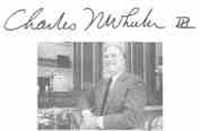POLITICS

Can Democratic lawmakers count on presidential coattails? by Charles N. Wheeler III When Democrats gather in Chicago later this month for their national nominating convention, they'll have a lot in common with devotees of one of the Windy City's most revered cultural institutions: the Lyric Opera. Like patrons at a Lyric presentation of, say, Aida, Democrats will witness a thoroughly entertaining spectacle, complete with lots of melodramatic oratory, some low-brow humor, a huge cast, immense sets, amazing costumes, a heroine to cheer, villains to loathe. And, like opera-goers everywhere, the Democratic conventioneers will know the conclusion of the drama before the curtain rises — President Bill Clinton will be the party nominee for a second term. Republicans, packing for the trip to San Diego, are no less certain of the outcome of their party shindig — Bob Dole will be the GOP standard-bearer. Political junkies looking for suspense might be tempted to find it by trying to factor the presidential sweepstakes into the battle for control of the General Assembly. The big unknown, of course, would be whether Clinton's current strength in Illinois — should it hold up through November — might translate into coattails long enough and strong enough to pull Democrats back into the legislative majorities they enjoyed for most of the last two decades. Democratic partisans might enjoy the president's current double-digit lead in the public opinion polls, but history affords some solace to Republicans.
Consider the record: Of the 12 presidential elections since World War II, five have been "blowouts" in Illinois, contests in which the winner's percentage was 10 or more points higher than the loser's. In only two instances out of 10 possibilities, though, did control of either the Senate or the House switch to the victor's party, and both of those merit footnotes. The most notable shift occurred in 1964, when Democrats rode President Lyndon B. Johnson's coattails to a 31-seat pickup and a 118-59 margin in the House. But 1964 was the year of the infamous "bedsheet ballot," when candidates for all of the then-177 House seats ran at-large following unsuccessful attempts to draw new legislative districts. Indeed, had each party not agreed to nominate only 118 candidates, the Democrats might have recorded a clean sweep. Even as LBJ was drubbing GOP nominee Barry Goldwater by almost a 60 percent to 40 percent margin, though, Democrats gained only two Senate seats, and Republicans emerged with a still-solid 33-25 majority. Eight years later, when President Richard M. Nixon ran away from Democrat George McGovern, 59 percent to 41 percent, Republicans picked up a new Senate seat added by the 1970 Constitution, for a 30-29 majority. House Democrats, however, bucked the tide to gain a seat and pare the GOP majority to 89-88. Clinton himself earned "blowout" status four years ago by outpolling President George Bush by a 48 percent to 35 percent margin. Despite the Democratic candidate's poll prowess, Republicans gained four seats to seize Senate control, 32-27, for the first time since the 1972 election. The GOP also gained five House seats, slicing the Democratic edge to 67-51. Critical to the GOP success in 1992 were the new legislative maps, which Republicans won the right to draw. Indeed, history suggests that cartography is more likely than coattails to determine the outcome of legislative races in a blowout presidential year. Consider, for example, the 1984 election, when President Ronald Reagan routed Democrat Walter S. Mondale by a 56 percent to 43 percent margin. Thanks to their 1981 redistricting, Democrats lost only two Senate seats and three House seats despite the Reagan landslide. The resultant GOP gains mattered little to legislative control; Democrats continued to hold the whip hand, 31-28 in the Senate and 67-51 in the House. While a runaway win in Illinois for a party's White House hopeful usually hasn't been accompanied by sea changes at the legislative level, the record suggests the victor's party may 42 ¦ August 1996 Illinois Issues be at some peril in the following off-year election. In eight out of a possible 10 cases, the party of the winning candidate lost seats in the following election. The exceptions both came in 1986, when the Democrats' majorities remained unchanged in the Senate and in the House. In the four other elections following presidential blowout years, Illinois voters turned House control over to the party whose candidate they had so soundly rejected just two years earlier, as they did in one Senate election. Again, however, the historic record probably needs a footnote. For example, the largest reversal of fortune occurred in 1966, when Democrats lost 40 of the seats they won in the at-large election two years earlier. When candidates were running once again in districts, voters gave Republicans a 99-78 advantage. In the Watergate-tainted election of 1974, Republicans dropped five Senate and 13 House seats, losing their majorities in both chambers.
That election inaugurated an era of Democratic ascendancy; with the exception of one two-year span in the House, Democrats remained in total control until 1992, when the GOP-engineered 1991 redistricting took its toll in the Senate. The newly minted map enabled Republicans to gain four seats and a 32-27 advantage. Two years later — the election after Clinton's blowout over Bush — the GOP completed its sweep, snatching 13 House seats for its current 67-54 majority and adding another Senate seat. The moral of this impromptu history lesson seems apparent. Even though nothing's over until the fat lady sings, Clinton's current poll numbers should cause neither Democratic rejoicing nor Republican lamentation at either party's down-the-ballot chances. Charles N. Wheeler III is director of the Public Affairs Reporting program at the University of Illinois at Springfield. Illinois Issues August 1996 ¦ 43 |
||||||||||||||||
